formerly eScholarship Editions


|
|
|
|
Browse by Title
All Titles | Public Titles
A | B | C | D | E | F | G | H | I | J | K | L | M | N | O | P | Q | R | S | T | U | V | W | Y | Z | OTHERYour request for titles beginning with C found 67 book(s). | Modify Search | Displaying 61 - 67 of 67 book(s) | |
| 61. |  | Title: Cry for luck: sacred song and speech among the Yurok, Hupa, and Karok Indians of northwestern California Author: Keeling, Richard Published: University of California Press, 1993 Subjects: Anthropology | Ethnomusicology Publisher's Description: The "sobbing" vocal quality in many traditional songs of northwestern California Indian tribes inspired the title of Richard Keeling's comprehensive study. Little has been known about the music of aboriginal Californians, and Cry for Luck will be welcomed by those who see the interpretation of music as a key to understanding other aspects of Native American religion and culture.Among the Yurok, Hupa, and Karok peoples, medicine songs and spoken formulas were applied to a range of activities from hunting deer to curing an upset stomach or gaining power over an uninterested member of the opposite sex. Keeling inventories 216 specific forms of "medicine" and explains the cosmological beliefs on which they were founded. This music is a living tradition, and many of the public dances he describes are still performed today. Keeling's comparative, historical perspective shows how individual elements in the musical tradition can relate to the development of local cultures and the broader sphere of North American prehistory. [brief] Similar Items |
| 62. | 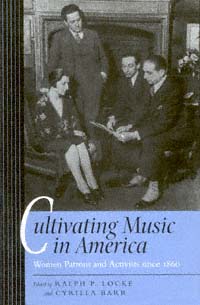 | Title: Cultivating music in America: women patrons and activists since 1860 Author: Locke, Ralph P Published: University of California Press, 1997 Subjects: Music | Women's Studies | Popular Culture Publisher's Description: This wide-ranging collection brings together leading authorities on the social history of American art music to reveal the indispensable contribution that women have made to American musical life. Some chapters discuss collective endeavors, such as music clubs, Wagnerites, supporters of "modern music" in the 1920s, and activists in African American communities, while others focus on the work of a single, strikingly individual patron such as Isabella Stewart Gardner or Elizabeth Sprague Coolidge. Primary sources such as private letters and autobiographies are utilized, and documentary vignettes scattered throughout the book bring to life important events and reminiscences. Among these are an interview with Betty Freeman, noted patron of avant-garde music, and advice from Mildred Bliss to Nadia Boulanger. Extensive opening and closing chapters provide conceptual and factual background on music in America and draw out the larger implications of women's patronage in the past, present, and future. [brief] Similar Items |
| 63. | 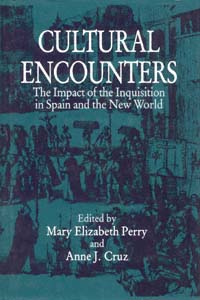 | Title: Cultural encounters: the impact of the Inquisition in Spain and the New World Author: Perry, Mary Elizabeth 1937- Published: University of California Press, 1991 Subjects: History | Anthropology | European History | Religion | Renaissance History Publisher's Description: More than just an expression of religious authority or an instrument of social control, the Inquisition was an arena where cultures met and clashed on both shores of the Atlantic. This pioneering volume examines how cultural identities were maintained despite oppression.Persecuted groups were able to survive the Inquisition by means of diverse strategies - whether Christianized Jews in Spain preserving their experiences in literature, or native American folk healers practicing medical care. These investigations of social resistance and cultural persistence will reinforce the cultural significance of the Inquisition. [brief] Similar Items |
| 64. | 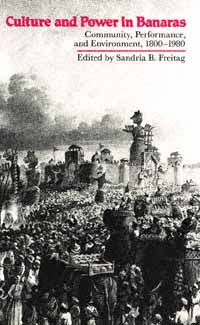 | Title: Culture and power in Banaras: community, performance, and environment, 1800-1980 Author: Freitag, Sandria B Published: University of California Press, 1989 Subjects: Asian Studies | South Asia | Asian History | Cultural Anthropology | Postcolonial Studies Publisher's Description: This collection of ten essays on Banaras, one of the largest urban centers in India's eastern Gangetic plain, is united by a common interest in examining everyday activities in order to learn about shared values and motivations, processes of identity formation, and self-conscious constructions of community. Part One examines the performance genres that have drawn audiences from throughout the city. Part Two focuses on the areas of neighborhood, leisure, and work, examining the processes by which urban residents use a sense of identity to organize their activities and bring meaning to their lives. Part Three links these experiences within Banaras to a series of "larger worlds," ranging from language movements and political protests to disease ecology and regional environmental impact. Banaras is a complex world, with differences in religion, caste, class, language, and popular culture; the diversity of these essays embraces those differences. It is a collection that will interest scholars and students of South Asia as well as anyone interested in comparative discussions of popular culture. [brief] Similar Items |
| 65. | 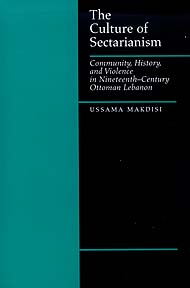 | Title: The culture of sectarianism: community, history, and violence in nineteenth-century Ottoman Lebanon Author: Makdisi, Ussama Samir 1968- Published: University of California Press, 2000 Subjects: History | Middle Eastern History | Middle Eastern Studies | Postcolonial Studies | Islam | Cultural Anthropology Publisher's Description: Focusing on Ottoman Lebanon, Ussama Makdisi shows how sectarianism was a manifestation of modernity that transcended the physical boundaries of a particular country. His study challenges those who have viewed sectarian violence as an Islamic response to westernization or simply as a product of social and economic inequities among religious groups. The religious violence of the nineteenth century, which culminated in sectarian mobilizations and massacres in 1860, was a complex, multilayered, subaltern expression of modernization, he says, not a primordial reaction to it. Makdisi argues that sectarianism represented a deliberate mobilization of religious identities for political and social purposes. The Ottoman reform movement launched in 1839 and the growing European presence in the Middle East contributed to the disintegration of the traditional Lebanese social order based on a hierarchy that bridged religious differences. Makdisi highlights how European colonialism and Orientalism, with their emphasis on Christian salvation and Islamic despotism, and Ottoman and local nationalisms each created and used narratives of sectarianism as foils to their own visions of modernity and to their own projects of colonial, imperial, and national development. Makdisi's book is important to our understanding of Lebanese society today, but it also makes a significant contribution to the discussion of the importance of religious discourse in the formation and dissolution of social and national identities in the modern world. [brief] Similar Items |
| 66. | 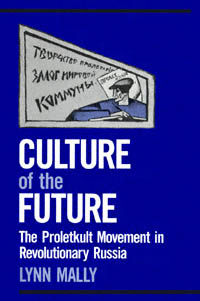 | Title: Culture of the future: the Proletkult movement in revolutionary Russia Author: Mally, Lynn Published: University of California Press, 1990 Subjects: Russian and Eastern European Studies | European History | Russian and Eastern European Studies Publisher's Description: Just days before the October 1917 Revolution, the Proletkult was formed in Petrograd to serve as an umbrella organization for numerous burgeoning working-class cultural groups. Advocates of the Proletkult hoped to devise new forms of art, education, and social relations that would express the spirit of the class that had come to power in the world's first successful proletarian revolution. Lynn Mally offers a detailed analysis of the Proletkult's cultural and political agenda. Drawing extensively on archival sources, she argues that the creation of a new culture proved as difficult and controversial as the creation of new notions of politics. From the outset, the Proletkult was divided by severe political and social tensions as members struggled to define the role of the organization and the cultural desires of the proletariat. What fused this divided movement was the shared belief that without radical cultural change the revolution would not succeed. The Proletkult's eventual decline graphically shows how political consolidation, institutional rivalries, and the devastating social consequences of the revolution and Civil War all worked together to limit the utopian potential of the October Revolution. [brief] Similar Items |
| 67. | 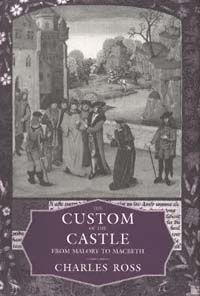 | Title: The custom of the castle: from Malory to Macbeth Author: Ross, Charles Stanley Published: University of California Press, 1997 Subjects: Literature | European History | English Literature | Medieval Studies | Renaissance Literature Publisher's Description: The "custom of the castle" imposes strange ordeals on knights and ladies seeking hospitality - daunting, mostly evil challenges that travelers must obey or even defend. This seemingly fantastic motif, first conceived by Chrètien de Troyes in the twelfth century and widely imitated in medieval French romance, flowered again when Italian and English authors adopted it during the century before Shakespeare's plays and the rise of the novel. Unlike other scholars who have dismissed it as pure literary convention, Charles Ross finds serious social purpose behind the custom of the castle.Ross explores the changing legal and cultural conceptions of custom in France, Italy, and England to uncover a broad array of moral issues in the many castle stories. He concentrates on single scenes that are common to a series of epics, showing how their nuanced narratives reflect real social limits of order, violence, justice, civility, and political conformity. His investigation of masterpieces from the thirteenth-century Lancelot to The Faerie Queene - by way of Malory, Boiardo, and Ariosto - demonstrates for the first time the impact on Shakespeare's plays, particularly Macbeth , of an earlier way of thinking about the strengths and weaknesses of social customs. [brief] Similar Items |